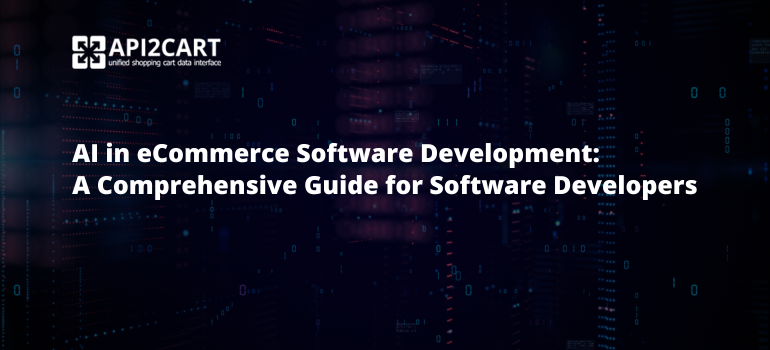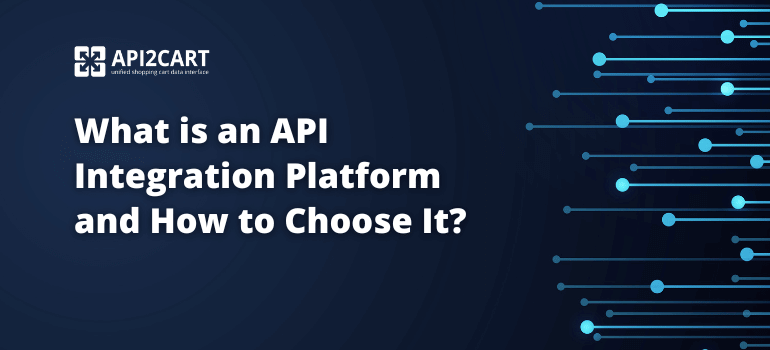
Artificial Intelligence (AI) has revolutionized the eCommerce industry, the way companies communicate with customers, and control processes. For the software developers, it is a great potential to implement AI into the eCommerce software. Since it opens a range of opportunities to create smart, responsive, and efficient applications that would help online store owners to address their needs. Beginning with recommendation engines and smart customer service chatbots ending with predictive analytics and automated inventory, AI technologies have become critical for any contemporary eCommerce solution.
In this comprehensive guide, we go deep into the use of AI in eCommerce software development, covering the methodologies, technologies and best practices that developers should master to thrive. If you are building a recommendation engine, chatbots, this article will give you a developer-focused view of how AI is being used in eCommerce. Software developers can use the tools, frameworks of AI to build cutting-edge eCommerce solutions that are both scalable and impactful.
Overview of AI in eCommerce
eCommerce is being transformed by AI to personalize more, automate more, and deliver better customer experiences. AI in eCommerce also has great potential for software developers, to build intelligent, data-driven software applications for streamlining of operations and driving business growth and improving customer experience.
Using eCommerce AI tools, software developers can create and develop sophisticated software applications, systems, programs and digital products that are data driven, user-friendly and highly adaptive. These solutions provide tremendous value to businesses in terms of increasing efficiency, improving customer experience and improving operational control.

Use Cases for AI in eСommerce Software Development
Here are some impactful AI use cases in eCommerce software development that can empower software developers to build innovative, high-performing solutions:
- Building Personalized Recommendation Engines: The analysis of user behavior, purchase patterns as well as browsing history is software developers’ opportunity to utilize the machine learning frameworks to develop recommendation systems. Popular eCommerce algorithms, such as collaborative filtering, content based filtering and hybrid recommendation models all aim to increase conversion rates and engagement of customers.
- Developing Intelligent Search and Discovery Solutions: NLP based search engines interpret the customer query better and provide more accurate results. Commonly used tools are Elasticsearch, with its NLP libraries. It includes an image recognition model to search by image and voice search integration using Google, Amazon or Microsoft NLP APIs to support natural language queries. To do this, developers can embed recommendation engines inside of search features to make the discovery experiences more engaging for the customers.
- Implementing AI-Powered Chatbots and Virtual Assistants: Platforms, such as Dialog Flow, Rasa and Microsoft’s Bot Framework make it natively easy for software developers to build chatbots that can handle customer queries, do recommendations and help troubleshoot. What’s cool about these chatbots is that they can integrate with CRM platforms to service customers based on their history with the company, boosting customer satisfaction and overall support.
- Enhancing Inventory and Supply Chain Management: Continuing using machine learning techniques, like time series forecasting, developers can predict inventory needs in order to avoid overstock and stockouts. Warehouse optimization, route planning and shipping forecast can be helped by AI to be more efficient. Effective route and process management can be done through the use of APIs and libraries for logistic optimization. As IoT is growing in the area of logistics, developers can now integrate IoT data with AI to track real time inventory and automate the processes.
- Developing Fraud Detection Systems: Using unsupervised machine learning, developers can use their own transactions to detect irregular patterns to detect fraudulent behavior. These models are usually built using frameworks. Deployed as real time monitoring AI models, these can be used to monitor transactions and keep the secure and reliable operation of customers and merchants. Fraud detection systems can be integrated with payment APIs (i.e. Stripe, PayPal) so that payments during checkout do not get processed.
- Implementing Automated Pricing and Merchandising: Prices can be flexed in response to demand, competition, seasonality all dynamically according to books. Regression and optimization algorithms are used by software developers for this purpose. By integrating AI powered merchandising systems into eCommerce platforms you can automatically arrange products based on customer preferences, trends, and performance analytics.
- Data Pipeline and Infrastructure Requirements: Continuous data is key to successful eCommerce AI models. However, you will need to set up pipelines for your data collection, storage, and preprocessing most likely using tools, such as Apache Kafka, AWS Glue, or Google BigQuery. Deploying AI models requires strong MLOps practices, by using these tools, such as Kubernetes, Docker or MLflow to monitor, as well as manage the models efficiently.
- Leveraging AI APIs and SDKs: Most cloud providers provide pre-trained AI models via APIs, allowing much easier integration and faster development. AI SDKs can be used for more customized solutions by developers, for example to add sophisticated functionalities such as sentiment analysis, product tagging and customer sentiment analysis with little overhead.

How Does AI in eСommerce Software Development Work
AI (Artificial Intelligence) in eCommerce software development means allowing software developers to bring intelligent, data driven features into eCommerce platforms. With these capabilities, a company could provide personalized shopping experiences, automate the support function, manage its inventory efficiently, and so much more. Here’s a breakdown of how it works and what it involves:
- Data Collection and Preprocessing: AI models need large amounts of data to train effectively. In eCommerce, the data sources are customer browsing history, purchase records, search queries and transaction data. This data needs to be collected, stored and preprocessed to make it clean and structured and that’s where data pipelines are established by developers. Big data in eCommerce is handled via tools, such as Apache Kafka, AWS Glue, Google BigQuery.
- Building Machine Learning Models: Machine learning (ML) algorithms are trained or reinforced to learn patterns, and/or make predictions, from historical data. A classic example of this would be a recommendation model which predicts a customer is going to buy which product based on previous behavior. For collaborative filtering and recommendations, developers choose and enable the appropriate ML models. For customer segmentation, clustering is the select and implement the ML models. So frameworks, such as TensorFlow, PyTorch and Scikit-learn are popular to build these models.
- Implementing NLP for Chatbots and Search Optimization: AI goes where natural language processing (NLP) goes, and that means it's invaluable to chatbots, customer support, and search optimization. Chatbot is used by the developers to understand the customers queries and respond in a proper way which is done using the NLP libraries (SpaCy, NLTK, Hugging Face) to train the chatbots. NLP is used to enhance search functionalities, with voice and text based search that interprets customer intent.
- Fraud Detection Systems: AI models examine transaction tendencies during transaction patterns to identify potential fraud by finding odd or even suspicious behavior in transactions. Anomaly detection models are built or pre-trained models are integrated to monitor transactions for fraud. Setting up your own APIs that connect to payment gateways is a great way to help ensure that fraudulent transactions never pass through.
- Inventory and Supply Chain Management: AI forecasts requirements of the inventory and automates the supply chain process to reduce stock outs and improve order fulfillment. Time series forecasting models are implemented by developers to predict demand, adjust stock levels, and automate order restocking. Using ML models integrated with inventory management systems, they can now automate this process and not need to be monitoring manually.
- Integration with Front-End and Back-End Systems: The existing eCommerce platform should be integrated with the AI functionality present on the front-end (customer interface) and the back-end (inventory, payment systems). The APIs or AI models are set up by developers who embed them into the platform. In addition to this, you need to develop user interfaces that show AI driven recommendations, chatbots or dynamic pricing in real-time.
With these AI technologies and frameworks applied, software developers can create adaptive, efficient and data driven eCommerce software applications and digital products that improve the shopping experience, streamline operations and grow the business. By understanding these use cases and techniques we can help developers build AI solutions for the current and future needs of modern eCommerce businesses.
Advantages of using AI
There are many advantages of using AI in your software development to develop more intelligent and more efficient applications. Here are some key benefits:
- Enhanced Productivity through Automation: AI can do automated repetitive and time consuming tasks like code generation, testing, bug detection, etc., and let developers work on a project.
- Improved Decision-Making with Data-Driven Insights: It allows you to quickly analyze a large dataset, and take action based on those insights to accelerate decision making in the areas of feature prioritization, user experience design and performance optimization.
- Enhanced Software Testing and Quality Assurance: AI powered testing tools allow you to test your software faster and more accurately with better quality software than manual testing.
- Real-Time Data Processing and Analytics: However, when software applications require real time insight, data processing becomes critical and AI makes this possible with real time processing. Real time analytics tools powered by machine learning allow developers to develop applications that change over time, changing dynamically with changing conditions.
- Enhanced Security through AI-Based Threat Detection: With AI and using existing tools to fix security weaknesses, you can monitor user behavior and spot anomalies in the system, and thus effectively secure against fraud, attacks and vulnerabilities.
- Optimized Resource Management: In cloud computing and infrastructure management the AI can be used to optimize the resource allocation and overhead cost and save the cost of resources and improve the utilization of resources. Predictive analytics can predict server loads and adjust computing resources as needed, and developers can keep the application performance without spending more.
- Increased Scalability and Adaptability: Large number of users and the ability to evolve over time means that an application can be more robust – requiring less change to requirements and increased scalability of the application itself. Adaptive algorithms which scale with more users without the need to completely reengineer the recommendation systems are possible.
- Cost Reduction with Efficient Processes: By automating and optimizing many development processes, AI reduces the need for manual interventions and therefore saves development costs. And reduce labor costs, and therefore minimize costly rework through automated testing, bug detection, and deployment processes.
AI in software development is useful because it gives developers better tools that shortens the process, raises software application quality and makes end users satisfied. In the end they offer more innovative, reliable, and cost effective solutions.

Сhallenges in Implementing AI in Software Development
But there are many benefits to using AI in software development, and of course challenges. Here’s a look at the key hurdles software developers face when integrating AI into applications:
- Data Availability and Quality: AI models need a lot of good quality data in order to work well. However, data collection, cleaning and preparation can be hard, especially if your data is fragmented, inconsistent or sparse. If models can’t have clean, structured data then they can potentially predict unreliable predictions and the AI solution is useless. In practice, developers may spend a lot of time preprocessing data in order to be able to train models well.
- Data Privacy and Compliance: Sensitive user data requires strict compliance (e.g. GDPR, CCPA). Data privacy and user consent are notoriously hard when data lives in separate systems. In order to achieve this, developers need to deliver strong data anonymization, encryption and user consent mechanisms, which may lead to more complexity in developing and in some cases limit the use of some of these data sources.
- Deployment and Integration Complexity: The planning involved when deploying AI models to production is because AI models can consume a lot of resources and, at times, have to be used with other systems. In order to model work with other application components, models have to be deployed, balanced things such as scaling, latency, API integration, and more while developers have to negotiate the challenges of deployment.
- Performance and Scalability: But when scaled for real time, real performance can be a problem because the AI models require a lot of memory and processing power. In the case of real time or high frequency application, the optimized model and infrastructure must run with a low latency and high performance. Usually, such a thing consists in compressing models or using some specialized hardware like GPUs.
- High Development Costs and Time Constraints: It costs money to develop AI models, you need special skills to use, you need special tools to work with, and then special infrastructure to build and deploy. That all compounds to additional time and expense for building and deployment. Budget and time constraints could also limit the scope of AI features developers can implement, or delay project timelines in smaller organizations, in particular.
Without careful planning and good understanding of AI principles and the tools, resources needed, these challenges cannot be addressed. This is where developers may consider these hurdles and avoid some of these pitfalls, embrace some of these best practices, and make smarter decisions when using AI in software development.
How API2Cart Helps Chatbots to Perform Their Functions?
API2Cart is a single API solution that makes it easy to integrate your chatbot software with many different eCommerce platforms. You can integrate your software with 60+ popular platforms, including Shopify, Magento, WooCommerce, BigCommerce etc. Integrating your chatbot software with eCommerce platforms allows you to easily offer the best support and a personalized experience to your customers. With many supported API2Cart API methods, you can work as efficiently as possible on the market and get all the data you need from your clients’ e-stores.
For example, your chatbot will be able to get and manage data on e-store products, customers, orders, and so on. Free for a month, you will be able to test functionality of this service and find out how this will let you connect your chatbot with several eCommerce platforms. Now all you have to do is get on the free trial account.
If you want to find out more about how API2Cart can assist you in saving money through chatbot automation and integration, and at the same time improve your chatbot’s capabilities and expand your market share, please don’t hesitate to contact us.
Conclusion
AI has become a game-changer in eCommerce, as software developers get tools to create smarter, more adaptable, and personal software applications, systems and digital products for online retail. Personalized recommendations, intelligent search, predictive analytics and automated inventory management are just a few of the new things that AI is enabling us to do to help customers have better experiences, as well as to simplify how companies manage their operations. Implementing AI isn’t easy, from data quality to model maintenance, but the rewards are huge for those who take it seriously and strategically.
For software developers, integrating AI into eCommerce solutions is more than a competitive edge. It’s a way to build scalable, future ready systems that will evolve with new user needs and deliver real business impact. Developers can learn to master the key AI techniques and know best practices for their use to create eCommerce platforms that not only help improve performance but also allow businesses to thrive in a data driven marketplace.



